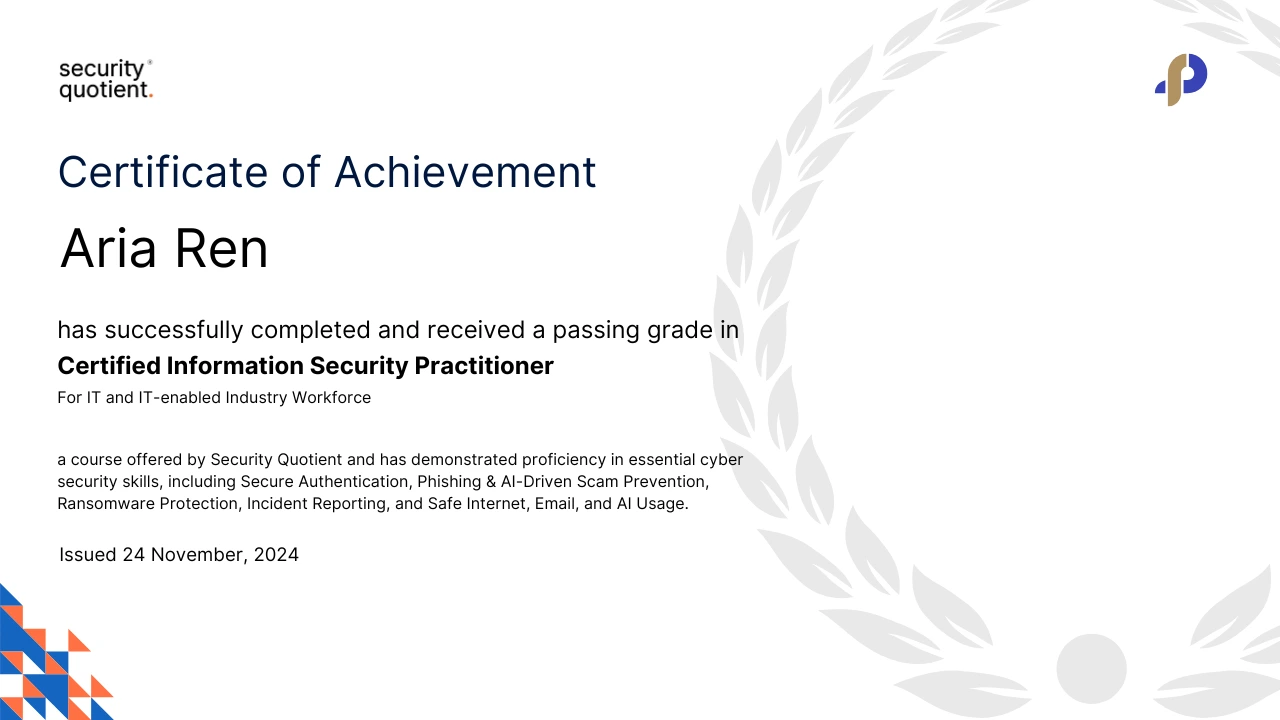Security Awareness Course
Certified Cyber Security Practitioner: GDPR
For the workforce in Organizations aiming for GDPR Compliance
Designed for organizations ensuring GDPR compliance, it covers key cyber threats, data protection principles, and the role of employees in safeguarding personal data.
Why this Course?
GDPR compliance is not just a legal requirement—it requires an informed and security-conscious workforce to protect personal data and reduce risks. This course ensures employees understand their role in handling, storing, and securing personal data, aligning with GDPR’s principles of privacy and security.
Designed for GDPR Compliance
Helps meet employee training requirements under GDPR.
Practical, Behavior-Focused Learning
Goes beyond theory, emphasizing real-world scenarios and decision-making.
Covers Security & Privacy Skills
Protects against data breaches, phishing, and unauthorized data access.
Supports a Strong Data Protection Culture
Empowers employees to recognize risks, follow data protection best practices, and ensure compliance.
Target Audience
This course is designed for employees at all levels in organizations handling personal data and ensuring GDPR compliance. It is ideal for:
– All employees who process or have access to personal or sensitive data.
– IT and security teams managing data protection and cyber security risks.
– Data Protection Officers (DPOs) and compliance teams ensuring GDPR adherence.
– HR, customer service, and marketing teams handling personal data daily.
– Executives and managers responsible for implementing GDPR policies.
No prior cyber security or data protection knowledge is required—this course provides practical, role-based training to help employees support GDPR compliance efforts.

Course Content
From understanding modern cyber threats to mastering data protection best practices, each module equips employees with practical skills to safeguard personal data and ensure GDPR compliance. The content is concise, actionable, and designed for professionals across industries, helping them apply secure behaviors in their daily roles while supporting their organization’s data privacy and security obligations.
Section 1. The Current Cyber Threat Landscape
As the digital landscape expands, cyber threats continue to evolve, targeting businesses of all sizes. This section provides a comprehensive overview of modern cyber risks, including emerging attack trends, data breaches, and evolving threat tactics. Participants will gain insights into how cybercriminals exploit vulnerabilities, the impact of these threats on business operations and data privacy, and why maintaining cyber vigilance is critical for GDPR compliance and data protection.
Research-Driven Insights
To create this section, we have used insights from the World Economic Forum Global Cyber Security Outlook – 2025 , which highlights the most pressing cyber threats and emerging trends affecting businesses worldwide. This research-driven approach ensures that participants are equipped with the latest knowledge to address real-world cyber security challenges.
Section 2. Modern Cyber Attacks: Threats and Prevention
Cyber attacks are becoming more sophisticated, targeting organizations through advanced techniques and vulnerabilities. In this section, participants will explore common modern cyber threats—such as phishing, ransomware, and AI-driven scams—and learn effective prevention strategies. The focus is on recognizing attack patterns, understanding how they work, and applying best practices to defend against them.
Section 3. Understanding GDPR
Cyber attacks are growing in sophistication, exploiting vulnerabilities in systems, processes, and human behavior to compromise sensitive data. This section explores key threats such as phishing, ransomware, and AI-driven cyber scams, highlighting their impact on data privacy and regulatory compliance, including GDPR. Participants will learn to identify attack patterns, understand cybercriminal tactics, and implement effective security measures to prevent data breaches and protect personal information in alignment with GDPR principles.
Section 4. Cyber Security and Data Protection Best Practices for GDPR Compliance
Under GDPR, protecting personal and business data is not just an IT responsibility—it is a shared duty among all employees. This section introduces 10 core cyber security and data protection practices that help organizations prevent data breaches, ensure secure handling of personal information, and maintain compliance with GDPR. Each best practice is supported by real-world examples and practical guidance to help employees integrate secure behaviors into their daily workflows.
4.1. Secure Authentication
Accessing company systems, emails, or cloud services requires strong authentication measures. Employees must use unique, complex passwords and enable multi-factor authentication (MFA) to prevent unauthorized access to personal and sensitive business data, aligning with GDPR’s principle of integrity and confidentiality.
4.2. Identifying and Avoiding Phishing & AI-Driven Scams
Phishing attacks remain one of the leading causes of data breaches under GDPR. Employees must be vigilant when receiving emails impersonating clients, vendors, or internal staff. Suspicious links and attachments should always be verified using a trusted contact method before interacting with them.
4.3. Preventing and Responding to Ransomware Attacks
Ransomware can encrypt personal and business data, violating GDPR’s data availability and integrity principles. Employees must avoid downloading unverified files, regularly back up their work, and report any ransomware alerts immediately to prevent widespread data loss.
4.4. Identifying and Reporting Cyber Security Incidents
Quick action is essential when a data breach or security incident occurs. Employees should report unauthorized access, system anomalies, or phishing attempts to the security team immediately, ensuring compliance with GDPR’s 72-hour breach notification rule.
4.5. Safe Internet and Email Practices
Using unsecured Wi-Fi or clicking on malicious links can expose sensitive personal and business data. Employees should use a VPN when working remotely, avoid accessing work accounts on public networks, and verify the legitimacy of email attachments and links before opening them.
4.6. Preventing Data Mishandling & Unauthorized Access
Mishandling personal data can result in GDPR violations and hefty penalties. Employees must follow company policies for storing, processing, and sharing data, ensuring that only authorized personnel have access to confidential information.
4.7. Securing Your Mobile Devices
Mobile devices accessing business applications or personal data must be encrypted, password-protected, and kept updated. Employees should enable biometric authentication, use company-approved security settings, and immediately report lost or stolen devices to prevent unauthorized data access.
4.8. Securing Remote Work Environments
Working remotely introduces risks to data security and GDPR compliance. Employees should use company-approved VPNs, ensure software and security updates are installed, and lock screens when leaving their workspace to prevent unauthorized access.
4.9. Safe Social Media Use
Oversharing on social media can lead to cybercriminals gathering sensitive information about an organization. Employees should be cautious when discussing business-related topics, avoid sharing confidential data, and follow company guidelines on social media use to prevent data leaks.
4.10. Safe AI Usage Practices
AI tools can process and analyze vast amounts of data, but improper usage can lead to GDPR non-compliance. Employees should only use AI tools in accordance with company policies, avoid entering personal or sensitive business information into public AI platforms, and verify AI-generated outputs for accuracy.
5. Other Data Protection and Compliance Regulations
This module provides an overview of key data protection and privacy regulations beyond GDPR, helping employees understand global compliance requirements. Learners will explore data protection laws in different regions, including:
– HIPAA (USA) – Regulations ensuring the privacy and security of healthcare data.
– UK Data Protection Act (DPA 2018) – UK-specific data protection framework aligned with GDPR.
– Singapore PDPA – Regulations governing the collection, use, and disclosure of personal data in Singapore.
– Malaysia PDPA – Data protection law for businesses handling personal data in Malaysia.
– India DPDP Act (2023) – India’s personal data protection framework.
– UAE PDPL – Data privacy law aligning with global standards in the UAE.
6. Summary and Results
In this final section, we reinforce the key cyber security and data protection principles covered throughout the course, emphasizing their role in GDPR compliance and safeguarding personal data. Participants will review critical best practices, reflect on their learning progress, and assess their understanding of secure behaviors. This section also provides a summary of cumulative assessment results, helping learners gauge their readiness to apply cyber security measures, protect sensitive information, and support their organization’s compliance efforts.
Certification for Successful Learners
Recognize and reward employees who successfully complete the course with a company-branded certificate, reinforcing their commitment to cyber security.
Minimum Passing Score – 80%
Learners who score 80% or higher receive an official co-branded certificate#.
Digital & Shareable
Learners can showcase their achievement internally or on platforms like LinkedIn.
Drive Engagement
Providing certification motivates employees to adopt security best practices.
Company-Branded Certificate#
Each certificate is customized with your organization’s name.

Sample certificate with client logo co-branding
# Client logo co-branding is available only in Premium and Enterprise Plans.
Assessment Method
Instead of relying on a single final test, assessments are integrated throughout the course to measure understanding and promote continuous learning. Participants will apply their knowledge in scenario-based challenges, encouraging critical thinking and secure decision-making in business contexts.
Continuous Assessments
Integrated assessments at the end of each section.
Scenario-Based Decision-Making
Real-world simulations instead of multiple-choice questions.
Pass Score
A score of 80% or more is required to pass the course.
No Final Test
Learn progressively with assessments throughout the course.
Course Features
A time-sensitive and concise course designed for professionals. Accessible on any device, with integrated assessments for practical learning.
Interactive E-Learning
Scenario-based, interactive content for real-world application.
Learning Time – 45 Minutes
Quick, focused learning with minimal disruption to work.
Delivery via Secure LMS
Hosted on our LMS for seamless access and tracking.
Mobile Responsive
Fully accessible across all devices for flexible learning.
How to Get This Course?
All our courses are available as part of our subscription plans.
Equip your workforce with essential cyber security skills through our flexible subscription plans. Our plans include:
– Full Access to All Courses – Get unlimited access to our entire training library containing courses and micro-learning.
– Progress Tracking & Analytics – Monitor employee progress with detailed insights.
– Company-Branded Certification – Recognize and certify successful learners#.
– Advanced Behaviour Analytics – Delve deep into learning data to identify poor cyber security behaviours and its impact#.
– Expert Support – Dedicated assistance to help you implement training effectively.
# Available in advanced plans.

